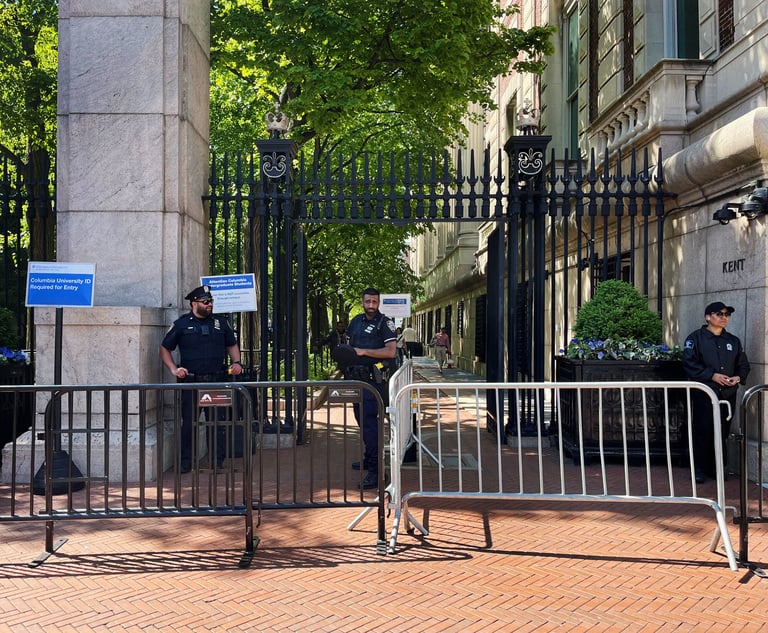Ahead of the Curve: Women Law Students Struggle More Outside of Class
The latest Law School Survey of Student Engagement reveals that while female law students are succeeding academically, their quality of life outside the classroom lags behind their male classmates.
December 17, 2019 at 11:15 AM
8 minute read
Welcome back to Ahead of the Curve. I'm Karen Sloan, legal education editor at Law.com, and I'll be your host for this weekly look at innovation and notable developments in legal education.
This week, I'm parsing the findings of the latest Law School Survey of Student Engagement, which conclude that women law students are keeping up academically, but their quality of life lags behind that of their male classmates. Next up, I'm checking in on UCLA Law's decision to increase the generosity of its Loan Repayment Assistance Program, following a trend among top law schools. And what about that so-called Trump Bump? It didn't lead to more people starting law school this fall.
Women Law Students Are Killing it. Or Are They?
The latest iteration of the Law School Survey of Student Engagement landed in my inbox last week and the title immediately caught my eye: The Cost of Women's Success. I was intrigued because that name indicated the report would poke at a widely held perception that women are crushing law school. More women than men are now enrolled (they are 54% of the current first-year class), and each year we hear more about women ascending to the top of the masthead at prestigious law journals and securing other highly sought-after co-curricular positions.
So what, exactly, it the "cost" they are paying for this success? The report was eye opening. But first, a quick primer on LSSSE. It's an extensive annual survey of how law students feel about their campus experience—this year's report covered 70 law schools, with responses for 18,000 students—and each year researchers focus in on a specific area of their findings to highlight. This year's spotlight was on the experience of women, and how it diverges from their male classmates.
Now for the findings. Women are doing just as well as men on the academic side. They reported grades on par or slightly higher than the male respondents, and on the whole they are more engaged with faculty and advisers. They rate their law school experience as either "good" or "excellent" in roughly the same percentage as men. But here's the rub: Their quality of life indicators are lower than those of their male classmates. Another way to think about that is that they are struggling more on the non-academic side of things. They reported:
➤➤Sleeping fewer hours than men. Among women, 51% said they were sleeping five hours or fewer per night, as compared with 43% of men.
➤➤Spending less time socializing. More than half of women—53%—said they spend five hours or less per week engaged in social activities. That figure was 38% among men.
➤➤Women are also getting less exercise. Among respondents, 70% of women said they spend five hours or less a week exercising, compared with 60% of men.
Additional family care responsibilities might explain at least some of these discrepancies. Among women, 11% said they spend 20 hours or more a week caring for dependents living with them, while 8.6 percent of men said they spend that much time caring for dependents.
One of the most disturbing findings in the study, however, centers on student debt and the literal cost women pay to pursue a law degree. Collectively, women law students expect to owe significantly more than their male classmates once they graduate. Among women, 19% expected to graduate with $160,000 or more in loans, while only 14% of men said they expected to have that level of debt. Even scarier is the fact that nearly 8% of women will graduate with upwards of $200,000 in debt, compared with 5.5% of men.
So why the disparity? I suspect that a good chunk of the difference boils down to who is getting merit scholarships to defray the cost of their legal education. For better or worse, scores on the Law School Admission Test factor heavily into merit aid. And women reported lower LSAT scores, on the whole, than did men. For example, 21% of men reported LSAT scores among the highest band of 161 and up, as compared with 16% of women. For the record, women overall reported higher undergraduate grade-point averages than did men.
Differing socioeconomic status could factor into the debt disparity as well. For example, women composed a higher percentage of first-generation college students than did men. Among women respondents, 30% were first-generation college students, as compared with 25% of men.
A few other findings in the study didn't surprise me at all, namely that men were significantly more likely than women to participate in classroom discussions—which is a phenomenon researchers have chronicled in academic settings for decades.
After reading the report, I couldn't decide if the findings were good news or bad news for women in law school. The fact that they are holding their own academically is obviously a bright spot, but the reality that they are struggling more on the wellness side of things—and taking on more debt—is troubling. So I hopped on the phone with LSSSE director Meera Deo to help me make sense of it all. And it turns out that she, too, had trouble easily encapsulating the findings.
"The results are mixed," Deo told me. "Yes, women have lower LSAT scores coming in but higher undergraduate GPAs, and their overall satisfaction rates are pretty great. Their [law school] grades are about the same, maybe slightly higher than men. So what gives? What gives is the quality of life part—the part that's more about creating these strong connections and spending time with other students. It's the down time we know is necessary to potentially make sure you don't run into mental health effects."
The takeaway: So what's to be done? How do we ensure that women law students are talking care of themselves better on the non-academic front? The report suggest that law school focus on better supporting students. When I pressed Deo on how they should do this, she mentioned having on-site counselors available for students; encouraging faculty to invest more time in students; and making sure the school has enough staff to help students in need. And when it comes to the debt disparity, schools should put less emphasis on LSAT scores when doling out merit scholarships. Sounds reasonable to me.
SPONSORED BY ALM
Boundless Opportunities: Being Ready for What Happens Next
Speaking to the increasing mobility and accelerating agility of the future-focused legal professional, Richard Robinson, director of legal operations and litigation Support at Toyota, is one of many industry thought leaders set to drive the business of law forward at Legalweek 2020. READ MORE

UCLA Ups The LRAP Ante
Earlier this year, I wrote about what looked to be an arms race among top law schools to improve their Loan Repayment Assistance Programs, which help graduates in lower-paying public interest positions pay back their student loans. (Student loans are emerging as a running theme in today's column.) We had Harvard, Columbia and NYU each improving the terms of their LRAPs within months of each other.
Now it seems that the trend of bolstering LRAPs is seeping beyond the T-14, albeit just beyond. UCLA law school—ranked No. 15 by U.S. News & World & Report—announced last week that it is changing the eligibility criteria for its program to help more people qualify. Previously, graduates in qualifying jobs earning less than $60,000 or less had their loans fully covered by the LRAP program, and those earning $60,000 to $80,000 were partially covered. Now, graduates in public interest jobs earning up to $75,000 are fully covered, and those earning up to $100,000 are partially covered. Not bad! Let hope that more schools follow suit.
Extra Credit Reading
Despite hype about a so-called "Trump Bump" fueling interest in law school, new data from the American Bar Association show that the number of students starting law school this fall actually fell slightly.
Law professors weigh in on why it takes weeks—sometime upwards of a month—for students to find out their finals grades.
Tyler Gordon, a 3L at West Virginia University School of Law, says his experience in moot court helped him to manage the pressure of a televised football-throwing contest which netted him a $100,000 prize.
Thanks for reading Ahead of the Curve. Sign up for the newsletter and check out past issues here. I'll be back next week with more news and updates on the future of legal education. Until then, keep in touch at [email protected]
This content has been archived. It is available through our partners, LexisNexis® and Bloomberg Law.
To view this content, please continue to their sites.
Not a Lexis Subscriber?
Subscribe Now
Not a Bloomberg Law Subscriber?
Subscribe Now
NOT FOR REPRINT
© 2024 ALM Global, LLC, All Rights Reserved. Request academic re-use from www.copyright.com. All other uses, submit a request to [email protected]. For more information visit Asset & Logo Licensing.
You Might Like
View All



Trending Stories
- 1AI Governance In Practice
- 2Section 1782 Practice Pointers From Recent Decisions
- 3Democratic State AGs Revel in Role as Last Line of Defense Against Trump Agenda
- 4Decision of the Day: Split Circuit Panel Bars Enforcement of Ivory Law's 'Display Restriction' on Antique Group Members
- 5Chiesa Shahinian Bolsters Corporate Practice With 5 From Newark Boutique
Who Got The Work
Michael G. Bongiorno, Andrew Scott Dulberg and Elizabeth E. Driscoll from Wilmer Cutler Pickering Hale and Dorr have stepped in to represent Symbotic Inc., an A.I.-enabled technology platform that focuses on increasing supply chain efficiency, and other defendants in a pending shareholder derivative lawsuit. The case, filed Oct. 2 in Massachusetts District Court by the Brown Law Firm on behalf of Stephen Austen, accuses certain officers and directors of misleading investors in regard to Symbotic's potential for margin growth by failing to disclose that the company was not equipped to timely deploy its systems or manage expenses through project delays. The case, assigned to U.S. District Judge Nathaniel M. Gorton, is 1:24-cv-12522, Austen v. Cohen et al.
Who Got The Work
Edmund Polubinski and Marie Killmond of Davis Polk & Wardwell have entered appearances for data platform software development company MongoDB and other defendants in a pending shareholder derivative lawsuit. The action, filed Oct. 7 in New York Southern District Court by the Brown Law Firm, accuses the company's directors and/or officers of falsely expressing confidence in the company’s restructuring of its sales incentive plan and downplaying the severity of decreases in its upfront commitments. The case is 1:24-cv-07594, Roy v. Ittycheria et al.
Who Got The Work
Amy O. Bruchs and Kurt F. Ellison of Michael Best & Friedrich have entered appearances for Epic Systems Corp. in a pending employment discrimination lawsuit. The suit was filed Sept. 7 in Wisconsin Western District Court by Levine Eisberner LLC and Siri & Glimstad on behalf of a project manager who claims that he was wrongfully terminated after applying for a religious exemption to the defendant's COVID-19 vaccine mandate. The case, assigned to U.S. Magistrate Judge Anita Marie Boor, is 3:24-cv-00630, Secker, Nathan v. Epic Systems Corporation.
Who Got The Work
David X. Sullivan, Thomas J. Finn and Gregory A. Hall from McCarter & English have entered appearances for Sunrun Installation Services in a pending civil rights lawsuit. The complaint was filed Sept. 4 in Connecticut District Court by attorney Robert M. Berke on behalf of former employee George Edward Steins, who was arrested and charged with employing an unregistered home improvement salesperson. The complaint alleges that had Sunrun informed the Connecticut Department of Consumer Protection that the plaintiff's employment had ended in 2017 and that he no longer held Sunrun's home improvement contractor license, he would not have been hit with charges, which were dismissed in May 2024. The case, assigned to U.S. District Judge Jeffrey A. Meyer, is 3:24-cv-01423, Steins v. Sunrun, Inc. et al.
Who Got The Work
Greenberg Traurig shareholder Joshua L. Raskin has entered an appearance for boohoo.com UK Ltd. in a pending patent infringement lawsuit. The suit, filed Sept. 3 in Texas Eastern District Court by Rozier Hardt McDonough on behalf of Alto Dynamics, asserts five patents related to an online shopping platform. The case, assigned to U.S. District Judge Rodney Gilstrap, is 2:24-cv-00719, Alto Dynamics, LLC v. boohoo.com UK Limited.
Featured Firms
Law Offices of Gary Martin Hays & Associates, P.C.
(470) 294-1674
Law Offices of Mark E. Salomone
(857) 444-6468
Smith & Hassler
(713) 739-1250









